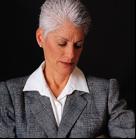Technical Communicator with Accessibility Needs Looking to Expand Knowledge
- Technical communicator, 16 years
- 59-years-old, married
- Bachelor of arts degree, Wellesley College; masters technical and professional writing, Northeastern University
- Human Factors in Informational Design masters program candidate at Bentley College
- Senior member of the STC
“I need to design an accessible website for my usability class.”
Margy is a principal technical writer for a healthcare company, and has been an employee there for the past ten years. She is an experienced writer who mentors the less seasoned writers in her department. Her documentation and training department is set up so that members offer their area of expertise to the other department members. To that effort, Margy is enrolled in a Masters program in Human Factors in Informational Design and offers her usability expertise to other members of her group.
Margy loves outdoor sports – biking (mountain and road), hiking, kayaking, skiing, and running. She said that riding motorcycles is fun but doesn’t provide much exercise. Her bookmarked sites include Google for searching, REI – Outlet (outdoor clothing), weather, MapQuest Music, and Wikipedia.
With age, Margy’s eyesight is changing and she has trouble reading words on the monitor clearly. To accommodate she sets her default browser font larger, and for sites that do not inherit the larger size she uses a magnifying browser plug-in with Firefox. Additional accommodations are bulleted in the section that describes her work environment. Her study partner is hearing impaired and has special accommodations concerning her own computer use.
Key Attributes
- Sixteen years of technical communication experience with ten years at her current company.
- In-depth knowledge of company products and product history from working on initial and update releases
- Skill at using Help authoring and publishing tools to produce deliverables
- Special focus on usability and human factors
Work Environment and Accommodations
- Listens to music to help her focus on work, because area around her cubicle is noisy and she is easily distracted.
- Uses widescreen desktop monitor because it’s easier to see what’s on the screen. In addition, she makes the screen as bright as possible.
- Prefers to print out content rather than read it on a computer to reduce eye and neck strain.
- Sends mail using a larger font size (bumps it up around 125%) and bolds items for easier reading.
- Resets her default font to sans-serif because she finds it hard to read content that is written with a serif font.
- Turns on captioning when watching online videos to accommodate her study partner’s hearing loss.
Tasks
- Uses RoboHelp to develop Help files, and is now transitioning to MadCap Flare.
- Uses Adobe FrameMaker and Acrobat to produce printed documentation.
- Reads books and articles on usability for class assignments.
- Conducts usability testing and studies usability and accessibility design practices for school.
Informational Needs/Goals
- Wants information on trends in the technical communication industry.
- Wants to know about new tools for streamlining her workflow.
- Needs to research designing websites for accessibility for a class assignment.
- Wants to network with other technical communication and usability professionals.
- Wants to find accommodations for her husband, also a technical writer, whose fingers tire easily from typing because they are numb from Diabetes
Scenario of Use: Margy Statler
- Margy is familiar with STC and naturally turns there first to seek information.
- First she looks around the site for any information about usability. The Google search on the site displays results about Usability presentations. [Please note that searching on www.google.com outside of the STC site produces more direct results on the Usability SIG, eliminating Step 3 below]
- She locates the SIG groups after mousing over the whole group of drop-down menus. She sees a link to “AccessAbility” and “Usability and User Experience.”
- She explores the AccessAbility site to find information to accommodate her eyesight, and her husband’s Diabetes. Then she visits the Usability and User Experience SIG site to see if there is any information that can help her with her studies.
Margy is an advanced user who would be able to understand the information design quickly and as a student of usability may even be able to offer some usability feedback to STC about the TCKP site.

